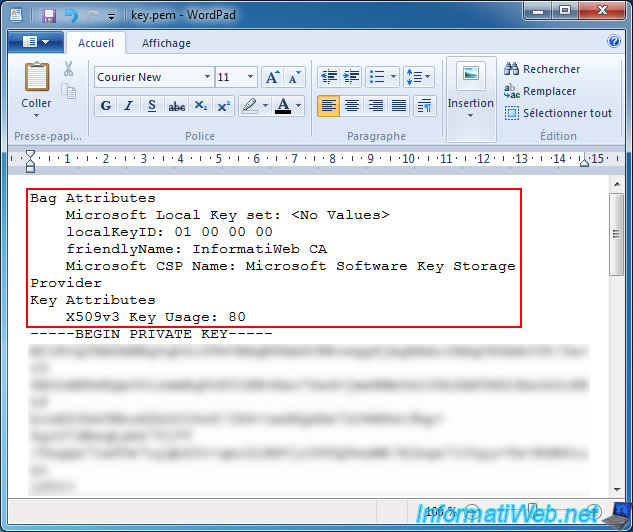Openssl Generate Private Key Pem Format
- Openssl Cer To Pem Format
- Private Key Definition
- Openssl Generate Private Key Pem Format Download
- Public Private Key Encryption
PKCS12 - A Microsoft private standard that was later defined in an RFC that provides enhanced security versus the plain-text PEM format. This can contain private key material. Its used preferentially by Windows systems, and can be freely converted to PEM format through use of openssl. DER - The parent format of PEM.
Common OpenSSL Commands with Keys and Certificates
Generating the Public Key - Windows 1. At the command prompt, type the following: openssl rsa -in rsa.private -out rsa.public -pubout -outform PEM 2. The public key is saved in a file named rsa.public located in the same folder. Generating the Private Key - Linux 1. Open the Terminal. Navigate to the folder with the ListManager directory. This means that you can simple copy and paste the content of a pem file to another document and back. Following is a sample PEM file containing a private key and a certificate, please note that real certificates are a couple of times larger, containing much more random text between the 'BEGIN' and 'END' headers.
And you can have private key in PKCS#1 or PKCS#8 format. The extensions (.der,.pem,.key,.cer etc.) are only for convenience to easily identify what is inside (well, we wish to trust that the content corresponds to the extension used). Command openssl genrsa -out rsaprivkey.pem 1024 generated private key in PKCS#1 format and PEM encoding. Openssl genrsa -des3 -out private.pem 2048 That generates a 2048-bit RSA key pair, encrypts them with a password you provide and writes them to a file. You need to next extract the public key file. You will use this, for instance, on your web server to encrypt content so that it can only be read with the private key. Sep 11, 2018 After you have downloaded the.pfx file as described in the section above, run the following OpenSSL command to extract the private key from the file: openssl pkcs12 -in mypfxfile.pfx -out privatekey.txt –nodes. Where mypfxfile.pfx is your Windows server certificates backup. This command will create a privatekey.txt output file.
Generate RSA private key with certificate in a single command
Generate Certificate Signing Request (CSR) from private key with passphrase
Generate RSA private key (2048 bit)
Generate a Certificate Signing Request (CSR)
Generate RSA private key (2048 bit) and a Certificate Signing Request (CSR) with a single command

Convert private key to PEM format
Generate a self-signed certificate that is valid for a year with sha256 hash
View details of a RSA private key
View details of a CSR
View details of a Certificate
View details of a Certificate in DER format
Convert a DER file (.crt .cer .der) to PEM

Convert a PEM file to DER
How do I convert my Amazon Elastic Compute Cloud (Amazon EC2) Privacy Enhanced Mail (.pem) file to a PuTTY Private Key (.ppk) file? Or, convert a .ppk file to a .pem file?
Short Description
PuTTY doesn't natively support the private key format (.pem) generated by Amazon EC2. You must convert your private key into a .ppk file before you can connect to your instance using PuTTY. You can use the PuTTYgen tool for this conversion. This tool, available for both Windows and Unix operating system, can convert keys.
Resolution
Windows - install PuTTYgen
Most Windows operating systems have PuTTY installed. If your system doesn't, download and install PuTTYgen.
Windows - convert a .pem file to a .ppk file
Start PuTTYgen, and then convert the .pem file to a .ppk file. For detailed steps, see Convert Your Private Key Using PuTTYgen.
Windows - convert a .ppk file to a .pem file
- Start PuTTYgen. For Actions, choose Load, and then navigate to your .ppk file.
- Choose the .ppk file, and then choose Open.
- (Optional) For Key passphrase, enter a passphrase. For Confirm passphrase, re-enter your passphrase.
Note: Although a passphrase isn't required, you should specify one as a security measure to protect the private key from unauthorized use. Using a passphrase makes automation difficult, because human intervention is needed to log in to an instance or to copy files to an instance. - From the menu at the top of the PuTTY Key Generator, choose Conversions, Export OpenSSH Key.
Note: If you didn't enter a passphrase, you receive a PuTTYgen warning. Choose Yes. - Name the file and add the .pem extension.
- Choose Save.
Openssl Cer To Pem Format
Unix or Linux - install PuTTY
Install PuTTY, if it's not already on your system.
Important: A PuTTY package is provided by the Extra Packages for Enterprise Linux (EPEL) repository. You must enable the EPEL repository before you install PuTTY.
To install PuTTY, run one of the following commands:
RPM-based
Private Key Definition
Dpkg-based
Unix or Linux - convert a .pem file to a .ppk file
On the instance shell, run the puttygen command to convert your .pem file to a .ppk file:
Unix or Linux - convert a .ppk file to a .pem file
Run the puttygen command to convert a .ppk file into a .pem file:
Openssl Generate Private Key Pem Format Download
Related Information
Anything we could improve? Download google apps for android 5.0.
Need more help?/avg-tuneup-2014-product-key-generator.html.